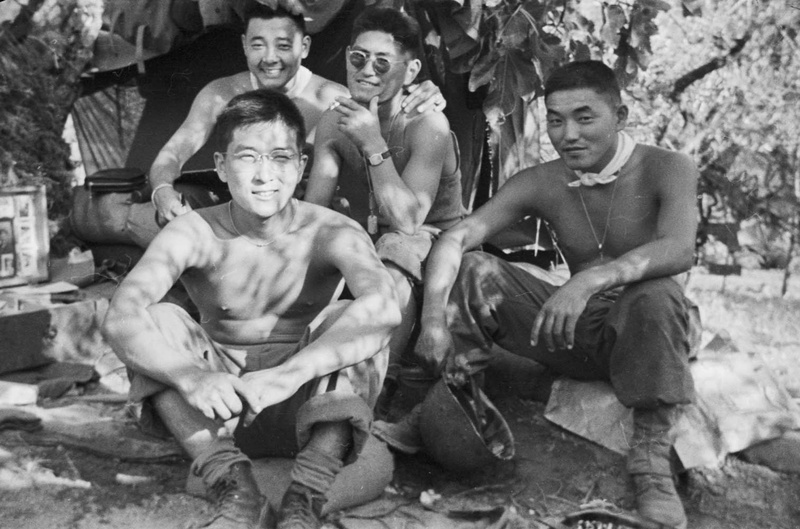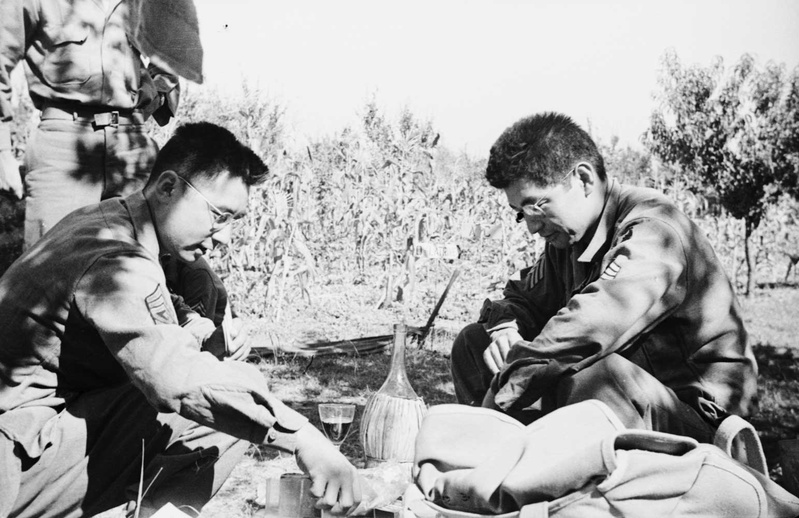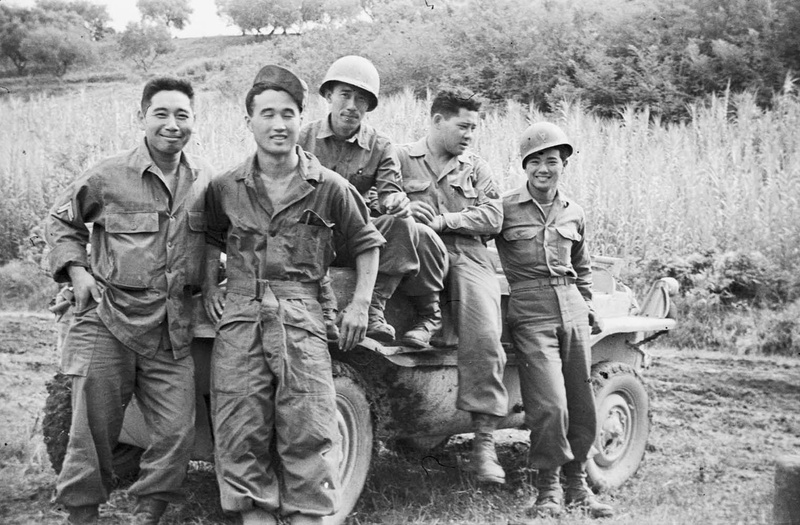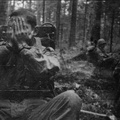“Abunai tokoro niwa ikanaide ne.” (Don’t go any where dangerous.)
—Hisayo Ito, mother of Sus Ito
In 1994, Susumu “Sus” Ito, a World War II veteran who served as a former lieutenant in the segregated all-Japanese American army, bequeathed a collection to the Japanese American National Museum (JANM) archive in Los Angeles.1 He donated over a dozen personal artifacts from the war, hundreds of photographs he took during wartime, as well as some sixty rolls of 35mm negatives which were still sealed in the film canisters and unseen since the end of the war.
Cameras were not allowed in his unit, but luckily for him and for history, the rules were ignored in favor of Sus Ito. He was a soldier first and photographer second, taking pictures when it was safe to do so. While serving in the military, Ito carried three things with him—a bible, a senninbari, and a 35mm Agfa camera. When it was time to change the film in his camera, he used his sleeping bag as a modified darkroom to avoid exposing the film to light. He wrapped the canisters in tin foil to protect them further.
We learned that the nearly sixty rolls of film had been processed as negatives during the war at local photo shops in Italy, France, and Germany and stored tightly wound in their original canisters for decades. In 2014, 1,153 images from those negatives were conserved physically and digitally into several hundred gigabytes of data. Those photographs are the images in the exhibition titled, Before They Were Heroes: Sus Ito’s World War II Images.
Sus Ito and the 14,000 Nisei servicemembers who served in the 442nd Regimental Combat Team, the 100th Infantry Battalion, the 522nd Field Artillery Battalion, the Military Intelligence Service, and the Women’s Army Auxiliary Corps left a mark in American history through their courage and tenacity during and after World War II. Their legacy has shaped the Japanese American community and forever immortalized the segregated Nisei unit as the bravest of soldiers. Their ordinary persona as young men and women in the military is overshadowed by their valiant heroism. In other words, we forget that they were regular people before they became decorated war heroes.
Ito’s photographs taken with an unauthorized camera visually humanize the stories of the Nisei who served in the 442nd Regimental Combat Team’s 522nd Field Artillery Battalion. The photographs reveal the day-to-day activities like preparing for meals, writing letters, and playing chess. The soldiers pose in front of their guns, tanks, historic sites, as well as their tents and their clean laundry. Ito carried the film negatives for nearly 4,700 miles across Europe and the Atlantic Ocean, and many of the photos have been unseen for nearly seventy years.
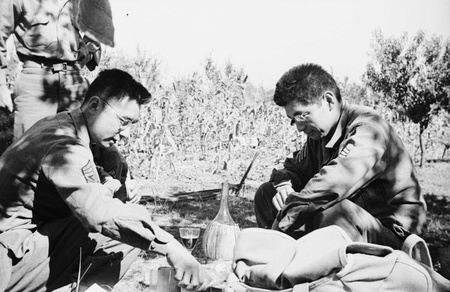
(Dr. Susumu Ito Collection, Japanese American National Museum [94.306])
Along with the photographs, one of the artifacts which will be on display is Sus Ito’s senninbari. A senninbari 千人針, (literally one thousand-person-belt), has its origins in Imperial Japan and is an amulet for a safe return home which is given to soldiers going to war. Often the mother or wife of a soldier, along with different women in the community, stitched 1,000 red stitches into a white cloth belt. The belt was intended to be worn while in battle. Sus’ mother made him a senninbari that he carried in his pocket during the war and didn’t share that he had it with anyone—even his closest friends. Like many other Nisei soldiers who received a senninbari from their loved ones, Ito kept it a secret because he simultaneously treasured it and was embarrassed to have it.
Today, we know that the Japanese American units were the most decorated in the history of the U.S. army, for their size. They received 21 Congressional Medals of Honor, 53 Distinguished Service Crosses, 588 Silver Stars, 5,200 Bronze Stars, and 9,486 Purple Hearts.2 They made history. They fought for democracy abroad and proudly represented the Japanese American community. All the while, many of their families were imprisoned in concentration camps because their physical features made them guilty of looking like the enemy.
The exhibition, Before They Were Heroes: Sus Ito’s World War II Images, illustrates why first person stories matter. It captures the youth and optimism of the soldiers who represented the Japanese American community. The photographs provide us with an insider’s view of the daily routine of the service members. Sus’ photos did not always document the grisly images we expect from warfare. Through this historical based exhibition and others like it, we can understand the importance of the Japanese American National Museum’s permanent collection.
We have the benefit of being on the hindsight of history and we know the outcome of the war. However at the time these photos were taken, Ito and his fellow soldiers didn’t know about Anne Frank and her diary, the Holocaust, the Battle of the Lost Battalion, if the U.S. would win the war, or what would happen to their families who were incarcerated in the American concentration camps. None of the Nisei knew they were making history when they were on the front lines of battle. Only in the aftermath do we come to realize the significance of their contributions during the war. Sus’ mother warned him about going into a dangerous situation, but he did anyway. As Sus Ito often stated, “I was one of thousands, just doing my job.”3
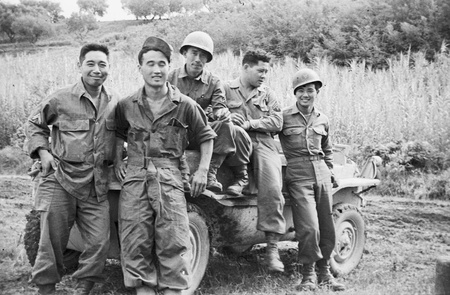
(Dr. Susumu Ito Collection, Japanese American National Museum [94.306])
Notes:
1. Born in 1919 in Stockton, California to Japanese immigrant parents, Susumu Ito (1919- ) grew up with few luxuries in the countryside. Like many other Japanese American families in their community, the Ito family worked as tenant farmers sharecropping and harvesting celery, beets, and asparagus. Sus Ito was drafted into the military in 1941 before America’s involvement in the war.
2. Lyn Crost, Honor By Fire: Japanese Americans at War in Europe and the Pacific (Novato: Presidio Press, 1994), 312.
3. Interview with Susumu Ito, Boston, Massachusetts, October 2014.
* * * * *
Before They Were Heroes: Sus Ito’s World War II Images
Japanese American National Museum
July 14 – September 6, 2015
Before They Were Heroes: Sus Ito’s World War II Images is the inaugural exhibition in Sharing Our Stories, a new series of exhibitions drawn from JANM’s extensive permanent collection. A celebration of the donation by Susumu “Sus” Ito of his vast archive of photographs and negatives taken while on duty during World War II, Before They Were Heroes gives the public a rare and breathtaking look at the daily lives of the 522nd Field Artillery Battalion of the celebrated all-Japanese American 442nd Regimental Combat Team.
© 2015 Japanese American National Museum; Lily Anne Y. Welty Tamai


